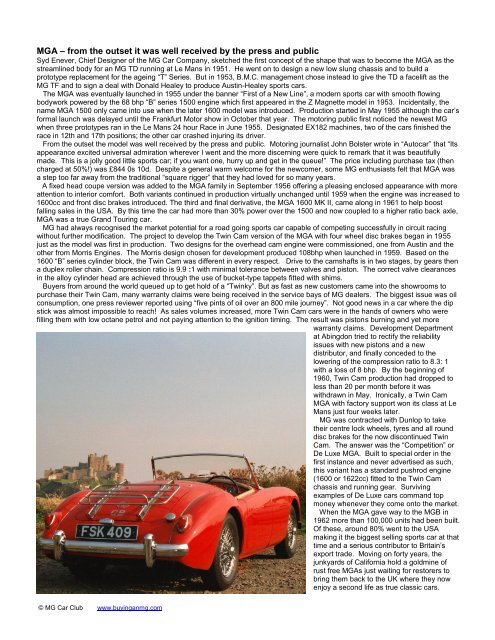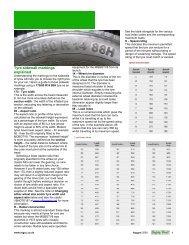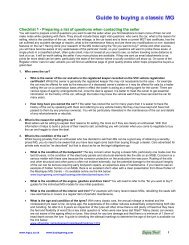You also want an ePaper? Increase the reach of your titles
YUMPU automatically turns print PDFs into web optimized ePapers that Google loves.
<strong><strong>MG</strong>A</strong> – from the outset it was well received by the press <strong>an</strong>d public<br />
Syd Enever, Chief Designer of the <strong>MG</strong> Car Comp<strong>an</strong>y, sketched the first concept of the shape that was to become the <strong><strong>MG</strong>A</strong> as the<br />
streamlined body for <strong>an</strong> <strong>MG</strong> TD running at Le M<strong>an</strong>s in 1951. He went on to design a new low slung chassis <strong>an</strong>d to build a<br />
prototype replacement for the ageing “T” Series. But in 1953, B.M.C. m<strong>an</strong>agement chose instead to give the TD a facelift as the<br />
<strong>MG</strong> TF <strong>an</strong>d to sign a deal with Donald Healey to produce Austin-Healey sports cars.<br />
The <strong><strong>MG</strong>A</strong> was eventually launched in 1955 under the b<strong>an</strong>ner “First of a New Line”, a modern sports car with smooth flowing<br />
bodywork powered by the 68 bhp “B” series 1500 engine which first appeared in the Z Magnette model in 1953. Incidentally, the<br />
name <strong><strong>MG</strong>A</strong> 1500 only came into use when the later 1600 model was introduced. Production started in May 1955 although the car’s<br />
formal launch was delayed until the Fr<strong>an</strong>kfurt Motor show in October that year. The motoring public first noticed the newest <strong>MG</strong><br />
when three prototypes r<strong>an</strong> in the Le M<strong>an</strong>s 24 hour Race in June 1955. Designated EX182 machines, two of the cars finished the<br />
race in 12th <strong>an</strong>d 17th positions; the other car crashed injuring its driver.<br />
From the outset the model was well received by the press <strong>an</strong>d public. Motoring journalist John Bolster wrote in “Autocar” that “Its<br />
appear<strong>an</strong>ce excited universal admiration wherever I went <strong>an</strong>d the more discerning were quick to remark that it was beautifully<br />
made. This is a jolly good little sports car; if you w<strong>an</strong>t one, hurry up <strong>an</strong>d get in the queue!” The price including purchase tax (then<br />
charged at 50%!) was £844 0s 10d. Despite a general warm welcome for the newcomer, some <strong>MG</strong> enthusiasts felt that <strong><strong>MG</strong>A</strong> was<br />
a step too far away from the traditional “square rigger” that they had loved for so m<strong>an</strong>y years.<br />
A fixed head coupe version was added to the <strong><strong>MG</strong>A</strong> family in September 1956 offering a pleasing enclosed appear<strong>an</strong>ce with more<br />
attention to interior comfort. Both vari<strong>an</strong>ts continued in production virtually unch<strong>an</strong>ged until 1959 when the engine was increased to<br />
1600cc <strong>an</strong>d front disc brakes introduced. The third <strong>an</strong>d final derivative, the <strong><strong>MG</strong>A</strong> 1600 MK II, came along in 1961 to help boost<br />
falling sales in the USA. By this time the car had more th<strong>an</strong> 30% power over the 1500 <strong>an</strong>d now coupled to a higher ratio back axle,<br />
<strong><strong>MG</strong>A</strong> was a true Gr<strong>an</strong>d Touring car.<br />
<strong>MG</strong> had always recognised the market potential for a road going sports car capable of competing successfully in circuit racing<br />
without further modification. The project to develop the Twin Cam version of the <strong><strong>MG</strong>A</strong> with four wheel disc brakes beg<strong>an</strong> in 1955<br />
just as the model was first in production. Two designs for the overhead cam engine were commissioned, one from Austin <strong>an</strong>d the<br />
other from Morris Engines. The Morris design chosen for development produced 108bhp when launched in 1959. Based on the<br />
1600 “B” series cylinder block, the Twin Cam was different in every respect. Drive to the camshafts is in two stages, by gears then<br />
a duplex roller chain. Compression ratio is 9.9 :1 with minimal toler<strong>an</strong>ce between valves <strong>an</strong>d piston. The correct valve clear<strong>an</strong>ces<br />
in the alloy cylinder head are achieved through the use of bucket-type tappets fitted with shims.<br />
Buyers from around the world queued up to get hold of a “Twinky”. But as fast as new customers came into the showrooms to<br />
purchase their Twin Cam, m<strong>an</strong>y warr<strong>an</strong>ty claims were being received in the service bays of <strong>MG</strong> dealers. The biggest issue was oil<br />
consumption, one press reviewer reported using “five pints of oil over <strong>an</strong> 800 mile journey”. Not good news in a car where the dip<br />
stick was almost impossible to reach! As sales volumes increased, more Twin Cam cars were in the h<strong>an</strong>ds of owners who were<br />
filling them with low oct<strong>an</strong>e petrol <strong>an</strong>d not paying attention to the ignition timing. The result was pistons burning <strong>an</strong>d yet more<br />
warr<strong>an</strong>ty claims. Development Department<br />
at Abingdon tried to rectify the reliability<br />
issues with new pistons <strong>an</strong>d a new<br />
distributor, <strong>an</strong>d finally conceded to the<br />
lowering of the compression ratio to 8.3: 1<br />
with a loss of 8 bhp. By the beginning of<br />
1960, Twin Cam production had dropped to<br />
less th<strong>an</strong> 20 per month before it was<br />
withdrawn in May. Ironically, a Twin Cam<br />
<strong><strong>MG</strong>A</strong> with factory support won its class at Le<br />
M<strong>an</strong>s just four weeks later.<br />
<strong>MG</strong> was contracted with Dunlop to take<br />
their centre lock wheels, tyres <strong>an</strong>d all round<br />
disc brakes for the now discontinued Twin<br />
Cam. The <strong>an</strong>swer was the “Competition” or<br />
De Luxe <strong><strong>MG</strong>A</strong>. Built to special order in the<br />
first inst<strong>an</strong>ce <strong>an</strong>d never advertised as such,<br />
this vari<strong>an</strong>t has a st<strong>an</strong>dard pushrod engine<br />
(1600 or 1622cc) fitted to the Twin Cam<br />
chassis <strong>an</strong>d running gear. Surviving<br />
examples of De Luxe cars comm<strong>an</strong>d top<br />
money whenever they come onto the market.<br />
When the <strong><strong>MG</strong>A</strong> gave way to the <strong>MG</strong>B in<br />
1962 more th<strong>an</strong> 100,000 units had been built.<br />
Of these, around 80% went to the USA<br />
making it the biggest selling sports car at that<br />
time <strong>an</strong>d a serious contributor to Britain’s<br />
export trade. Moving on forty years, the<br />
junkyards of California hold a goldmine of<br />
rust free <strong><strong>MG</strong>A</strong>s just waiting for restorers to<br />
bring them back to the UK where they now<br />
enjoy a second life as true classic cars.<br />
© <strong>MG</strong> Car Club<br />
www.buying<strong>an</strong>mg.com





